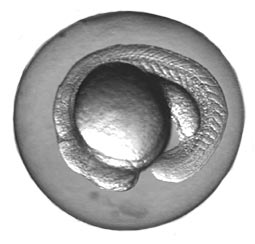|
Dr. Tanguay suspects something in the stream water is harming the fish. She collects water from the stream and takes it back to her lab. She hypothesizes that one of two things may be happening:
Dr. Tanguay starts by doing a simple experiment to guide further investigation. To set up the experiment, Dr. Tanguay sets up four fish tanks:
|
Tanks 1 and 3 are the experimental treatments. Tanks 2 and 4 are the control treatments. Dr. Tanguay knows the water in Tanks 2 and 4 is free of any contaminant that could harm fish. She will compare the fish or eggs in these control treatments to the fish and eggs in the experimental treatments. If they turn out different, She will know the problem is something in the water. It is necessary to use clean water that is known to be free of contaminants to compare the effects of the stream water.
For the experiment, Dr. Tanguay uses zebrafish, a small black and white striped fish native to India. Zebrafish live in warm freshwater streams. They are often found in pet stores in the United States.

Adult zebrafish
|
Why Use Zebrafish? |
Zebrafish are often used in lab experiments for several reasons:

Transparent developing
zebrafish embryo |
|
What Happened to the Fish? |
 |